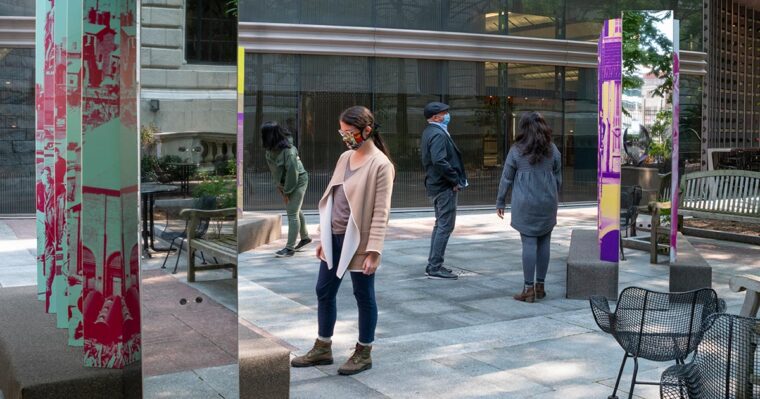Rose DeSiano’s public monument, “Reflect & Refract Democracy,” engages the Eastman Garden
Public education is democracy playing out. It’s the democracy of knowledge, how people should have access to information across all levels, classes, and educations. So it’s perfect to have that work in a public space like a library. Rose DeSiano, Reflect & Refract Democracy Even in these times of social distancing, visitors to Cleveland Public […]


Public education is democracy playing out. It’s the democracy of knowledge, how people should have access to information across all levels, classes, and educations. So it’s perfect to have that work in a public space like a library.
Rose DeSiano, Reflect & Refract Democracy

Even in these times of social distancing, visitors to Cleveland Public Library’s Eastman Reading Garden can enjoy an in-person, up-close-and-personal experience with Reflect and Refract Democracy, a new public art installation by Brooklyn-based artist Rose DeSiano that complements the Library’s Democracy 2020 campaign.
Reflect and Refract Democracy consists of six lenticular or tabula scalata walls displaying historic Cleveland photographs divided into vertical strips; the images appear to change when viewed at different angles. Prisms and mirrors reflect not only light and photography, but the visitors themselves. This interactive surface creates “a monument for the people,” DeSiano says.
“The idea is that people themselves can be reflected into the work,” she explains. “I’m interested in integrating the landscape with local history, as well as getting historic imagery out of the archives and into the public.”
In her project statement, DeSiano adds that she intends for this work to engage visitors “in an interactive system of reflections, refractions, and nonlinear history—echoing the system of democracy, for which the artwork has been designed to celebrate.”
Bringing History to Life

The exhibition’s walls showcase photographs that represent three aspects of American democracy: protest, leisure, and labor, all to create an impression of what it is to live and work in the United States. DeSiano sourced the images from Cleveland Public Library’s Photograph Collection, the Library of Congress, and Cleveland State University’s Cleveland Memory Project.
Visitors can wander through the maze-like arrangement of the walls to view historic photographs of Cleveland, including the Gordon Park bathing pavilion in 1908; the West Side Market in 1927; an arrest made during Communist march in the 1930 Cleveland Unemployment Strike; the 1944 Cleveland East Ohio Gas explosion; Public Square in 1948; the aftermath of the 1966 Hough Uprising; the 2020 Black Lives Matter protests in Cleveland; and more. The images are listed in detail on DeSiano’s website.
In addition to the lenticular walls, two orbital monuments honor Cleveland women notable for their political activism and cultural contributions. This part of the exhibit commemorates the 100th anniversary of the 19th Amendment, which guaranteed American women the right to vote. (African American women, however, continued to face voter disenfranchisement after the amendment passed.) The photographs appear on moveable extensions that are reflected in the orbs to represent an evolving, interactive system rather than a static historical movement.
These women, whom DeSiano calls “the unsung heroines of Cleveland,” include:
- Lucia McCurdy McBride (1880-1970), who founded and directed the Cleveland Woman Suffrage Party and Ohio Woman Suffrage Association, served as president of the League of Women Voters of Cleveland, and helped establish Cleveland’s first birth control clinic.
- Edith Anisfield Wolf (1889-1963), a poet, philanthropist, education advocate, and founder of the Anisfield-Wolf Book Awards. Upon her death, she willed her books to Cleveland Public Library.
- Helen Maria Chesnutt (1880–1969), an African American educator and author who taught Latin for many years at Central High School, where poet Langston Hughes was her student.
- Jean Murrell Capers (1913-2017), the first African American woman elected to Cleveland City Council and an advocate for women. She established the Black Women’s Forum in 1968.
- Jane Edna Hunter (1882-1971), an African American social worker who established the Working Girls Association in 1911 (later known as the Phillis Wheatley Association) to provide safe living quarters for homeless, unmarried African American women.
- Florence E. Allen (1884-1966), the first woman to serve on a state Supreme Court and one of the first two women to serve as a United States federal judge. She became one of Cleveland’s leading suffragists and was a vigorous speaker, debater, organizer, and fundraiser.
The Role of Public Art
“I’ve always seen public art an opportunity for people who might not have regular access to art to be enchanted by and immersed in it,” DeSiano says. “To give that experience to someone who doesn’t typically have art in their lives is my goal as an artist.”

Aaron Mason, Director of Outreach and Programming Services, adds that Reflect and Refract Democracy serves as a bridge between the past and the present. It also fits the Library’s focus on democracy in 2020. “Photography is one of the most democratic artistic mediums,” he says. “It’s accessible to nearly everyone.”
Accessibility is not only a big part of what draws DeSiano to public art, but it’s also why a library strikes her as an ideal place for an installation like Reflect and Refract Democracy.
“Public education is democracy playing out. It’s the democracy of knowledge, how people should have access to information across all levels, classes, and educations. So it’s perfect to have that work in a public space like a library,” DeSiano says. “Plus, the photographs in this exhibit come from a collection that’s accessible to the public. It’s all about democratic access.”
Reflect and Refract Democracy is made possible through Library’s partnership with LAND Studio, which brings public art to the Eastman Reading Garden every year through the See Also program. Democracy: Reflect and Refract will be on display through November 30, 2020 in the Eastman Reading Garden, located between Main Library and Louis Stokes Wing on Superior Avenue downtown.
